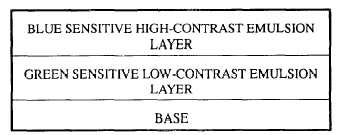associated with the picture can be heard during
playback
Floppy disks used in electronic imaging can be
reused for endless times-the same as any other magnetic
recording medium. No chemicals or darkroom tech-
niques are required to produce these images. Once the
image is captured on the floppy disk, it can be
transmitted over the telephone lines, edited, and printed
using a video printer-all under normal room-lighting
conditions.
BLACK-AND-WHITE PRINTING PAPER
The performance and use of black-and-white
photographic printing paper, like black-and-white films,
depends on the characteristics of the paper material.
While the many types of photographic papers differ in
their characteristics, they all basically consist of the
emulsion on a paper support or base. Photographic
printing papers (both black and white and color) are
manufactured in both various cut sheet sizes, ranging
from 5x7 to 20x24 inches and rolls up to 1,000 feet long.
Photographic papers used in Navy imaging
facilities are either coated with polyethylene or are
resin-coated. These papers are coated on both sides of
the base. This clear coating is treated so the paper does
not stick to the surface of other prints during processing.
Polyethylene-coated papers (manufactured by Ilford)
can be marked on with pencils and pens. Coated papers
have water-resistant bases that provide short processing
times. Most black-and-white papers with these coatings
have developing agents incorporated in the emulsion.
The developing agents are activated when the paper is
exposed to an alkali solution. The characteristics of
resin-coated paper make it ideal for machine processing,
but they may also be tray-developed in a regular print
developer.
The image on black-and-white film is usually
negative or recorded in tones of gray in reverse of the
reflective brightness values of a scene. When the
negative image is projected onto black-and-white paper,
the resulting image is positive or recorded in tones of
gray relative to the reflective brightness values of the
original scene. A negative is usually used or viewed by
transmitted light. A paper print (or simply a print) is
usually viewed by reflected light and may be referred to
as a reflection print or reflection positive.
Emulsion Sensitivity
The emulsions used for printing paper are much
slower (less sensitive to light) than most film emulsions.
Figure 2-7.–Cross section of variable-contrast black-and-white
paper.
A high sensitivity to light is not needed. Prints are often
manipulated by providing additional exposure or by
holding back exposure to selected areas of the print. If
the paper emulsions were fast, exposure times would be
extremely short and print manipulation would not be
possible.
The color or spectral sensitivity of a paper emulsion
indicates the response to specific colors of light or
radiation-the same as that for a film emulsion. The terms
colorblind, orthochromatic, and panchromatic are also
used to describe the spectral sensitivities of paper
emulsions. The response of a paper emulsion to
wavelengths other than ultraviolet radiation, violet, and
blue light is achieved by the addition of sensitizing dyes
to the emulsion during manufacturing.
The ranges of sensitivity for all paper emulsions
begin in the near-ultraviolet region of the invisible
portion of the electromagnetic spectrum. The color
sensitivity of undyed silver emulsions extend to blue and
blue-green. Panchromatic printing papers are sensitive
to ultraviolet radiation, violet, blue, green, and red light.
The color sensitivity of a black-and-white paper is NOT
a determining factor for selecting a paper to print a
specific black-and-white negative. Panchromatic
papers, however, are normally used to produce
black-and-white prints from color negatives. Color
sensitivity DOES determine whether or not a safelight
is required an, if so, what color of safelight can be used.
Variable Contrast Papers
Variable contrast papers are used almost exclusively
in Navy imaging facilities. The contrast of the print
image on variable contrast papers is controlled by the
specific color of the exposing light. Variable contrast
papers have two emulsion layers. The top layer is a
high-contrast emulsion and is sensitive to blue light. The
second emulsion layer is a low-contrast emulsion and is
sensitive to green light (fig. 2-7). When a normal
contrast negative is exposed through a variable contrast
filter with blue light, a harsh, contrasty print is produced.
2-9



